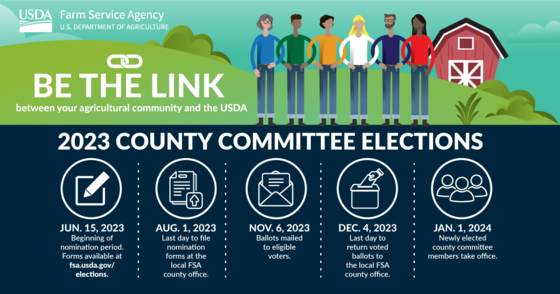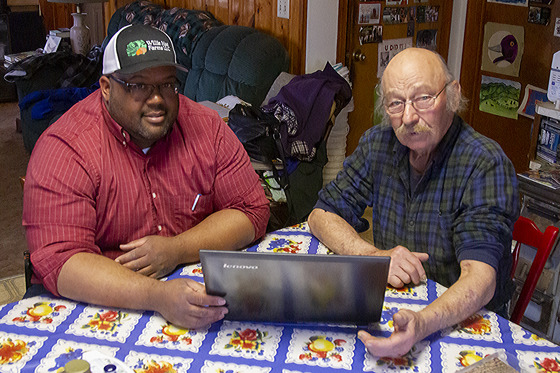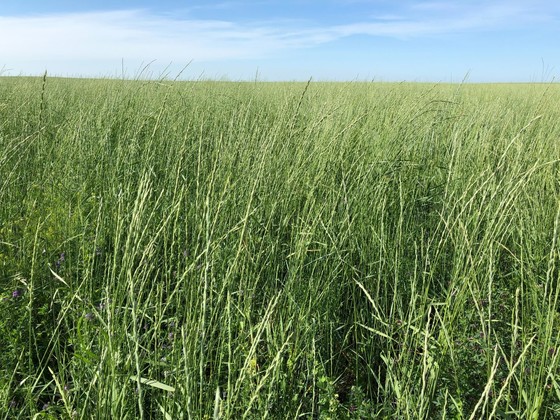 USDA applicants can set up a Farmers.gov account to review updates, complete online forms, and review FSA maps. Click on the photo to set up your account.
- Crop Reporting Deadlines
- County Committee Nominations - August 1
- Organic Dairy Marketing Assistance Program - August 11
- NAP Coverage for Native Grass and Mixed Forage - September 1
- NAP Coverage for Value Loss and Controlled Environment Crops - September 1
- Value Loss and Controlled Environment includes aquaculture, flowers, and Christmas trees
- Emergency Conservation Program - October 13
Click on the photo to download the FSA-669 County Committee Nomination Form!
Farmers and ranchers have until Aug. 1, 2023, to nominate candidates to serve on the NAME County Farm Service Agency (FSA) Committee. The U.S. Department of Agriculture (USDA) accepts nominations each year in certain Local Administrative Areas (LAAs) for individuals to serve on these locally led committees.
"The Aug. 1 deadline is quickly approaching,” said Russell Todd, acting executive director for FSA in San Luis Obispo County. "Committee members play a critical role in the day-to-day operations of the agency and are vital to how FSA carries out disaster programs, as well as conservation, commodity and price support programs. This is your opportunity to have a say in how federal programs are delivered in our county.”
This year, NAME County is accepting nominations for LAA 3, which includes Creston, Shandon, Pozo, and Carrizo Plains. Agricultural producers who participate or cooperate in a USDA program, and reside in the LAA up for election this year, may be nominated for candidacy for the county committee. A cooperating producer is someone who has provided information about their farming or ranching operation to FSA, even if they have not applied or received program benefits.
Nationwide, more than 7,700 dedicated members of the agricultural community serve on FSA county committees. The committees are made up of three to 11 members who serve three-year terms. Individuals may nominate themselves or others and qualifying organizations may also nominate candidates. USDA encourages minority producers, women and beginning farmers or ranchers to nominate, vote, and hold office.
Producers should contact their local FSA office today to register and find out how to get involved in their county’s election, including if their LAA is up for election this year. To be considered, a producer must be registered and sign an FSA-669A nomination form. The form and other information about FSA county committee elections are available at fsa.usda.gov/elections.
Election ballots will be mailed to eligible voters beginning Nov. 6, 2023.
Click on the photo to see the farm loan discovery tool!
The U.S. Department of Agriculture (USDA) has developed a simplified direct loan application to provide improved customer experience for producers applying for loans from the Farm Service Agency (FSA). The simplified direct loan application enables producers to complete a more streamlined application, reduced from 29 to 13 pages. Producers will also have the option to complete an electronic fillable form or prepare a traditional, paper application for submission to their local FSA farm loan office. The paper and electronic versions of the form will be available starting March 1, 2023.
Approximately 26,000 producers submit a direct loan application to the FSA annually, but there is a high rate of incomplete or withdrawn applications, due in part to a challenging and lengthy paper-based application process. Coupled with the Loan Assistance Tool released in October 2022, the simplified application will provide all loan applicants access to information regarding the application process and assist them with gathering the correct documents before they begin the process. This new application will help farmers and ranchers submit complete loan applications and reduce the number of incomplete, rejected, or withdrawn applications.
In October 2022, USDA launched the Loan Assistance Tool, an online step-by-step guide that provides materials to help an applicant prepare their farm loan application in one tool. Farmers can access the Loan Assistance Tool by visiting farmers.gov/farm-loan-assistance-tool and clicking the ‘Get Started’ button. The tool is built to run on any modern browser like Chrome, Edge, Firefox, or the Safari browser. A version compatible with mobile devices is expected to be available by the summer. It does not work in Internet Explorer.
The simplified direct loan application and Loan Assistance Tool are the first of multiple farm loan process improvements that will be available to USDA customers on farmers.gov in the future. Other improvements that are anticipated to launch in 2023 include:
- An interactive online direct loan application that gives customers a paperless and electronic signature option, along with the ability to attach supporting documents such as tax returns.
- An online direct loan repayment feature that relieves borrowers from the necessity of calling, mailing, or visiting a local Service Center to pay a loan installment.
USDA provides access to credit to approximately 115,000 producers who cannot obtain sufficient commercial credit through direct and guaranteed farm loans. With the funds and direction Congress provided in Section 22006 of the Inflation Reduction Act, USDA took action in October 2022 to provide relief to qualifying distressed borrowers while working on making transformational changes to loan servicing so that borrowers are provided the flexibility and opportunities needed to address the inherent risks and unpredictability associated with agricultural operations.
Soon, all direct loan borrowers will receive a letter from USDA describing the circumstances under which additional payments will be made to distressed borrowers and how they can work with their FSA local office to discuss these options. Producers can explore all available options on all FSA loan options at fsa.usda.gov or by contacting their local USDA Service Center.
Click on the photo to see how to report your numbers!
Producers in San Luis Obispo County are eligible to apply for 2023 Livestock Forage Disaster Program (LFP) benefits on native grass.
LFP provides compensation if you suffer grazing losses for covered livestock due to drought on privately owned or cash leased land or fire on federally managed land.
County committees can only accept LFP applications after notification is received by the National Office of qualifying drought or if a federal agency prohibits producers from grazing normal permitted livestock on federally managed lands due to qualifying fire. You must complete a CCC-853 and the required supporting documentation no later than January 30, 2024, for 2023 losses.
For additional information about LFP, including eligible livestock and fire criteria, contact the San Luis Obispo County USDA Service Center at (805) 434-0396 ext. 2 or visit fsa.usda.gov.
 USDA announced it is ramping up hiring for key positions that will help strengthen agricultural conservation efforts and turn President Biden’s Investing in America agenda into action. The available positions include engineers, civil engineering technicians and natural resource specialists, building on other large-scale hiring announcements earlier this year.
Today’s announcement is funded by $19.5 billion from President Biden’s Inflation Reduction Act. The new NRCS engineers and engineering technicians will play a critical role in solving a host of natural resource problems for agricultural producers and local communities. Their projects may involve stream restoration, erosion control, developing water systems for livestock, improving and conserving irrigation water and restoring wetlands. They may also help communities recover from natural disasters.
Natural resource specialists perform a variety of duties to help landowners meet their conservation objectives. This may include assisting in the implementation of conservation plans, conducting scientific studies and performing on-site evaluations with customers. Their work enhances conservation program delivery and helps build resilient farms and communities across America.
How to Apply
NRCS posted an announcement for engineering technicians on June 26 and natural resource specialists on July 3. Interested candidates can find more information and apply by searching for these job titles on USAjobs.gov.
To qualify for these positions, candidates must meet the education requirements, or a combination of education and experience requirements, as outlined in the job announcement. General qualifications for the engineering and natural resource management job series are also available on OPM.gov. Additional information on career opportunities at NRCS is available on the agency’s careers webpage.
More Information
Over the next several years, NRCS expects to add over 4,400 new employees to its federal workforce, in addition to over 3,000 team members through partner organizations, to help with Inflation Reduction Act implementation.
NRCS is a federal agency that helps farmers, ranchers and forest landowners conserve soil, water and other natural resources. Employees provide technical expertise and conservation planning. Financial assistance is available for a wide variety of conservation programs. NRCS has offices in USDA Service Centers nationwide.
 USDA is accepting more than 1 million acres in this year’s Conservation Reserve Program (CRP) General signup. This is one of several signups that USDA’s Farm Service Agency (FSA) is holding for the program. The results for CRP General signup reflect the continued importance of CRP as a tool to help producers invest in the long-term health, sustainability, and profitability of their land and resources. Offers for new land in this General CRP signup totaled about 295,000 acres nationwide. Producers submitted re-enrollment offers for 891,000 expiring acres, reflecting the successes of participating in CRP longer term. The total number of CRP acres will continue to climb in the coming weeks once FSA accepts acres from the Grassland CRP signup, which closed May 26. Additionally, so far this year, FSA has received 761,000 offered acres for the Continuous CRP signup, for which FSA accepts applications year-round. The number of accepted acres that are enrolled in General CRP will be confirmed later this year. Participating producers and landowners should also remember that submitting and accepting a CRP offer is the first step, and producers still need to develop a conservation plan before contracts become effective on October 1, 2023. Each year, during the window between offer acceptance and land enrollment, some producers ultimately decide not to enroll some accepted acres, without penalty.
General CRP Signup
The General CRP Signup 60 ran from February 27 through April 7, 2023. Through CRP, producers and landowners establish long-term, resource-conserving plant species, such as approved grasses or trees, to control soil erosion, improve soil health and water quality, and enhance wildlife habitat on agricultural land. In addition to the other well-documented benefits, lands enrolled in CRP are playing a key role in climate change mitigation efforts across the country. In 2021, FSA introduced improvements to the program, which included a new Climate-Smart Practice Incentive to increase carbon sequestration and reduce greenhouse gas emissions. This incentive provides an annual 3, 5, or 10 percent incentive payment based on the predominant vegetation type for the practices enrolled – from grasses to trees to wetland restoration.
Other CRP Signups
Grassland CRP is a working lands program that helps producers and landowners protect grassland from conversion while enabling haying and grazing activities to continue. Lands enrolled support haying and grazing operations and promotes plant and animal biodiversity. Lands are also protected from being converted to uses other than grassland. This year’s signup for Grassland CRP ran from April 17 through May 26. Continuous CRP, in which producers and landowners can enroll throughout the year. Offers are automatically accepted provided the producer and land meet the eligibility requirements and the enrollment levels do not exceed the statutory cap. Continuous CRP includes the State Acres for Wildlife Enhancement (SAFE) Initiative, the Farmable Wetlands Program (FWP), and the Conservation Reserve Enhancement Program (CREP). In CREP, which is available in certain geographies, partnerships with States, Tribes, and other entities are leveraged for participants to receive a variety of added incentives and flexibilities. Also available is the Clean Lakes Estuaries and Rivers (CLEAR) initiative. CLEAR30, a signup opportunity under that initiative available nationwide, gives producers and landowners across the country the opportunity to enroll in 30-year CRP contracts for water quality practices.
To learn more about FSA programs, producers can contact their local USDA Service Center. Producers can also prepare maps for acreage reporting as well as manage farm loans and view other farm records data and customer information by logging into their farmers.gov account. If you don’t have an account, sign up today.
-
San Luis Obispo County FSA Committee Meeting: Thursday, August 10, 2023 at 9:00 AM.
- Questions? Contact Russell Todd at russell.todd@usda.gov
- If you would need to request an accommodation, please contact Russell Todd at (661) 281-2764 or russell.todd@usda.gov, to request accommodations (e.g., an interpreter, translator, seating arrangements, etc.) or materials in an alternative format (e.g., Braille, large print, audiotape – captioning, etc.)
|